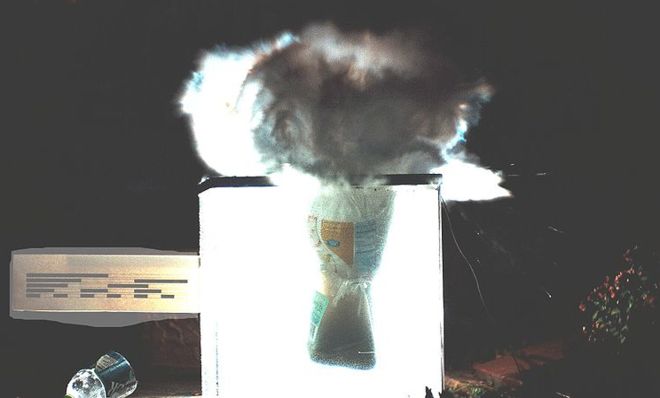Watch: Are dry ice bombs really a threat to airport security?
LAX airport baggage handler Dicarlo Bennett was arrested for setting off at least two dry ice bombs. Is this a thing?


On Sunday night, Terminal 2 of Los Angeles International Airport was briefly closed after a dry ice bomb exploded in an employee restroom. On Monday night, another dry ice bomb was discovered and disarmed on the tarmac outside LAX's Tom Bradley International Terminal. The employee who found it said he'd cleaned up the remnants of a similar bomb in the same area Sunday night, but only realized what it was after finding the fizzing bottle 24 hours later.
Tuesday night, police arrested Dicarlo Bennett, a 28-year-old employee of the ground handling company Servisair, on charges of exploding a "destructive device near an aircraft." Police didn't speculate on the motive behind the dry ice explosions. "Whether you think this is a harmless prank or a way to disrupt operations at the airport, it won't matter," said Los Angeles Police Department Chief Charlie Beck. "You will go to jail."
All three bombs were in restricted areas off-limits to the public, and no injuries were reported. But police and federal agents took the explosions seriously. So, just what is a dry ice bomb, and how dangerous are they?
The Week
Escape your echo chamber. Get the facts behind the news, plus analysis from multiple perspectives.

Sign up for The Week's Free Newsletters
From our morning news briefing to a weekly Good News Newsletter, get the best of The Week delivered directly to your inbox.
From our morning news briefing to a weekly Good News Newsletter, get the best of The Week delivered directly to your inbox.
A dry ice bomb is pretty much exactly what its name suggests: An explosive device fueled by dry ice, a frozen form of carbon dioxide. Making the bomb is "scarily easy," says Charlotte Alter at Time. All you do is drop dry ice pellets into a bottle of water, seal the top, and run. "As the dry ice sublimates (changes directly from solid to gas) it expands, creating pressure inside the container, which eventually explodes." This can take as little as a few seconds.
This video from the Discovery Channel explains the science behind the bombs, walks us through making one, and then shows a dry ice bomb exploding in spectacular slow motion — with the all-caps warning "DO NOT TRY THIS AT HOME."
Like any explosive device, dry ice bombs can be dangerous. The LAX and Discovery Channel bombs were made using plastic bottles, which tend to make big pops but cause little damage — though shards of ice or plastic could injure anybody near the explosion. But "dry-ice bombs made in glass or metal containers — or in containers that also have nails or other shrapnel items in them — can be especially dangerous," says Marc Lallanilla at LiveScience.
Dry ice isn't especially hard to get ahold of — lots of people use it at this time of year to make spooky fog at haunted houses or Halloween displays. And airports have ample amounts of dry ice on hand, since vendors commonly use it to keep food cold. The combination of simple construction, easily obtained materials, large crowds, and passenger aircraft makes dry ice bombs a potential danger to airline passengers.
A free daily email with the biggest news stories of the day – and the best features from TheWeek.com
But the primary danger of the bombs is psychological. "It's hard to get into the mind of a bomber, but if you're a bomber, this is not the kind of device you would make if you want to kill people," John Goodpaster, director of Indiana University's forensic sciences program, tells ABC News. "There's much more lethal ways to put a device together."
Bennett can tell that to the judge. He isn't the first person to set off a dry ice bomb in public, or even in the Los Angeles area. In May, a Disneyland employee was arrested on suspicion of detonating a dry ice bomb in a Mickey's Toontown garbage can, and in July, police arrested a man for placing one on a street in Silicon Valley's Redwood City. A police officer in Long Beach, Calif., was injured in a dry ice explosion in 2011.
The most likely victim of a dry-ice bomb is the person assembling it. So seriously, don't try this at home. But also be aware that if you try it outside your home, in a public place, you could go to jail. That's especially true in any U.S. airport. If the TSA won't let you bring a small knife on a plane, your potentially nonlethal explosive device isn't going to be treated as a laughing matter.
Peter has worked as a news and culture writer and editor at The Week since the site's launch in 2008. He covers politics, world affairs, religion and cultural currents. His journalism career began as a copy editor at a financial newswire and has included editorial positions at The New York Times Magazine, Facts on File, and Oregon State University.
-
 Trump’s poll collapse: can he stop the slide?
Trump’s poll collapse: can he stop the slide?Talking Point President who promised to ease cost-of-living has found that US economic woes can’t be solved ‘via executive fiat’
-
 Sudoku hard: December 7, 2025
Sudoku hard: December 7, 2025The daily hard sudoku puzzle from The Week
-
 Codeword: December 7, 2025
Codeword: December 7, 2025The daily codeword puzzle from The Week
